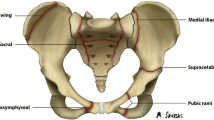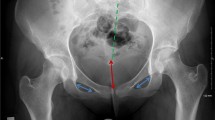Summary
The roentgenograms of 310 children treated for ankle fractures were evaluated for grouping according to the classifications of Ashhurst-Bromer-Weber, Lauge-Hansen, and Salter-Harris. The mean age of the children at the time of injury was 11.1 years (range 2–14 years). Two hundred twenty-one (71.3%) children had malleolar fractures, 71 (22.9%) had tibial epiphyseal fractures, and 18 (5.8%) had syndesmotic lesions. The age distribution of fractures was typical: malleolar fractures predominated among the younger children, epiphyseal fractures among the older. Only the oldest children had avulsion fractures of the syndesmosis. Grouping of the fractures according to Lauge-Hansen and Ashhurst-Bromer-Weber, classifications suited to adults, was largely unsuccessful. Epiphyseal fractures, moreover, were easily classified according to Salter-Harris. In spite of their complexity, ankle fractures in children can be roughly divided into avulsional and epiphyseal fractures. Adequately reduced avulsional fractures can be expected to heal well; epiphyseal fractures, however, may give rise to late complications. We propose, therefore, that ankle fractures in children be classified on the basis of roentgenological findings with respect primarily to epiphyseal lesions as well as on an additional simple grouping as to risk for clinical purposes: Group 1, low risk, avulsional fractures and epiphyseal separations; Group II, high risk, fractures through the epiphyseal plate.
Zusammenfasung
Es werden die Röntgenaufnahmen von 310 wegen Sprunggelenksfraktur behandelten Kindern beurteilt und nach den Klassifikationen von Ashhurst-Bromer-Weber, Lauge-Hansen und Salter-Harris eingeteilt. Das Durchschnittsalter der Kinder zum Zeitpunkt der Verletzung war 11,1 Jahre (2–14 Jahre). 221 Kinder (71,3%) hatten Malleolarfrakturen, 71 (22,9%) epiphysare Frakturen von Tibia und 18 (5,8%) Syndesmosenverletzungen. Die Altersverteilung der Frakturen war typisch: Malleolarfrakturen überwogen bei den jüngeren Kindern, epiphysäre Frakturen bei den älteren. Nur die ältesten Kinder hatten Syndesmosensprengungen.
Die Klassifizierung der Frakturen nach Lauge-Hansen und Ashhurst-Bromer-Weber, deren Einteilungen für Frakturen Erwachsener geeignet sind, war weitgehend unmöglich. Epiphysäre Frakturen waren leicht nach Salter-Harris zu klassifizieren.
Trotz ihrer Komplexität kann man Sprunggelenksfrakturen bei Kindern grob in Avulsions- und Epiphysenfrakturen einteilen. Adäquat reponierte Avulsionsfrakturen lassen ein gutes Behandlungsergebnis erwarten; Epiphysenfrakturen führen häufiger zu Spätkomplikationen. Die Autoren empfehlen deshalb, Sprunggelenksfrakturen bei Kindern sowohl auf der Grundlage des Röntgenbefundes unter besonderer Berücksichtigung der Epiphysenschädigungen als auch nach einer zusätzlichen einfachen Einteilung, die das Komplikationsrisiko für klinische Belange mit einbezieht, zu klassifizieren: Gruppe I geringes Komplikationsrisiko; Avulsionsfrakturen und Epiphysenlösungen. Gruppe II hohes Komplikationsrisiko; Frakturen durch die Epiphysenplatte.
Similar content being viewed by others
References
Aitken AP (1936) The end results of the fractured distal tibial epiphysis. J Bone Jt Surg 18:685
Ashhurst APC, Bromer RS (1922) Classification and mechanism of fractures of the leg bones involving the ankle. Arch Surg 4:51
Bishop PA (1932) Fractures and epiphyseal separation fractures of the ankle. Am J Roentgenol 28:49
Carothers CO, Crenshaw AH (1955) Clinical significance of a classification of epiphyseal injuries at the ankle. Am J Surg 89:879
Cooperman DR, Spiegel PG, Laros GS (1978) Tibial fractures involving the ankle in children. J Bone Jt Surg 60-A:1040
Danis R (1949) Les fractures malléolaires. Théorie et pratique de l'ostéosynthèse. Masson, Paris
Dias LS, Tachdjian MO (1978) Physeal injuries of the ankle in children. Clin Orthop 136:230
Gill GG, Abbott LC (1941) Varus deformity of the ankle following injury to distal epiphyseal cartilage of tibia in growing children. Surg Gynec Obstet 72:659
Johnson EW, Jr, Fahl JC (1957) Fractures involving the distal epiphysis of the tibia and fibula in children, Am J Surg 93:778
Keet DJGM (1970) Oorspronkelijke stukken. Enkelletsels bij kinderen. Ned T Geneesk 114:1360
Kleiger B, Mankin HJ (1964) Fracture of the lateral portion of the distal tibial epiphysis. J Bone Jt Surg 46-A:25
Klossner O (1962) Late results of operative and non-operative treatment of severe ankle fractures; A clinical study. Acta Chir Scand Suppl 293
Langenskiöld A (1967) Traumatic premature closure of the distal tibial epiphyseal plate. Acta Orthop Scand 38:520
Lauge-Hansen N (1942) Ankelbrud. I. Genetisk diagnose og reposition. Diss Munksgaard, København
Lauge-Hansen N (1950) Fractures of the ankle II. Combined experimental surgical and experimental roentgenologic investigations. Arch Surg 60:957
Lynn MD (1972) The triplane distal tibial epiphyseal fracture. Clin Orthop 86:187
Marmor L (1970) An unusual fracture of the tibial epiphysis. Clin Orthop 73:132
McFarland B (1931) Traumatic arrest of epiphyseal growth at the lower end of the tibia. Br J Surg 19:78
Salter RB, Harris WR (1963) Injuries involving the epiphyseal plate. J Bone Jt Surg 45-A:587
Slätis P (1979) Classification of ankle fractures. Lecture at the meeting of Finnish Orthopaedic Association March, 9
Solonen KA, Lauttamus L (1965) Treatment of malleolar fractures. Acta Orthop Scand 36:321
Spiegel PG, Cooperman DR, Laros GS (1978) Epiphyseal fractures of the distal ends of the tibia and fibula. J Bone Jt Surg 60-A:1046
Weber BG (1966) Die Verletzungen des oberen Sprunggelenkes. Aktuelle Probleme in der Chirurgie, III. Hans Huber, Bern Stuttgart
Author information
Authors and Affiliations
Rights and permissions
About this article
Cite this article
Vahvanen, V., Aalto, K. Classification of ankle fractures in children. Arch. Orth. Traum. Surg. 97, 1–5 (1980). https://doi.org/10.1007/BF00381520
Received:
Published:
Issue Date:
DOI: https://doi.org/10.1007/BF00381520




